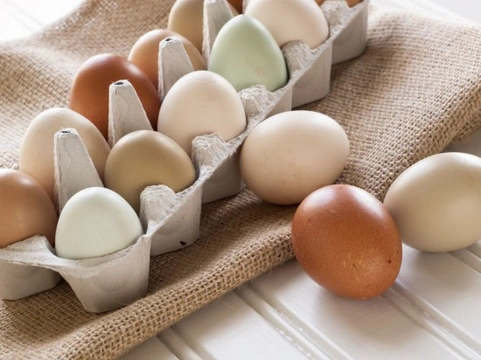
Chicken breeds and their egg colours
Are you thinking about owning chickens? Hens lay a variety of coloured eggs so let's break away from supermarket brown eggs and design a colourful egg box. Here is a guide to help you choose chickens based on egg colour.
What colour eggs?
Hens lay small, medium and large, white, brown, cream, brown with darker brown speckles, blue, olive, and green coloured eggs.
Pure breed or hybrid chicken?
All chickens' best egg laying time is within the first two years and then the amount of eggs will reduce. It is good to have a mixture of purebred and hybrid chickens. Purebred chicken lay fewer eggs a year, but live longer. Hybrid chickens are bred to lay more eggs, but have a shorter lifespan than a purebred chicken. Purebred chickens lay 150 to 200 eggs a year, which averages out to one or two eggs per week. Hybrids lay 300 eggs a year on average, so you can expect to get five eggs a week. Chickens will moult and stop laying over winter.There are advantages to both types of chickens. Pure breed chickens have a greater personality than hybrids, look more exotic, and come in a range of interesting colours. Disadvantages are that pure breed chickens have a tendency to go broody. Hybrids lay more eggs, more regularly. They can go broody too, but it is not as common. They all make great pets though.
Pure breed Chickens
AraucanaChoose a Lavender Araucana for perfect baby blue eggs for at least five years. The eggs are small to medium sized. Araucana's make great family pets. They are easy to tame, very friendly, and hardy chickens. They are rather quirky chickens. Their voice is quite gruff and croaky. They sport a pea comb and fluffy head feathers that cover their eyes. This is officially called a crest, which they enjoying dunking in water. Their plumage is lavender in colour and they have a short fantail. What a beautiful chicken! Appenzeller SpitzhaubenThese are the Dalmatians of the chicken world. Their plumage is white with black spots and they sport a quirky crest of feathers on their heads. They lay 140 to 160 medium to large white eggs per year. They love to forage for hours. Appenzeller's make excellent pets; they are very friendly and are happy to be carried around like a dog. It is recommended to keep a close eye on them, as they love to roost in trees.SilkieSilkies are the kittens of the chicken world. Their feathers are fluffy and fur like and their ear lobes are bright blue. They have black skin, feathered feet and an extra toe. They are the most docile of the chicken breeds. Famous people in America keep them as house pets and carry them around like tiny dogs!They come in miniature, bantam and large sizes. The only rule of thumb is to choose chickens of similar sizes and introduce into their new run at the same time. A large fowl silkie is still smaller than a large fowl hybrid chicken. A large fowl speckledy and a large silkie can live together happily if introduced correctly. The smaller silkie may follow the speckledy around as if she's her mother. They come in white, black, partridge, cuckoo, chocolate, red, blue and gold colours. Silkies lay from one to three small white eggs per week. They are the most broody of hens.Cream LegbarThis hen lays blue or sometimes even green eggs. You can be certain your hen will not turn into a cockerel with this auto-sexing breed. Chicks can be sexed from one day old. A Cream legbar lays 180 blue eggs per year. They are large fowl with a speckled grey plumage and an apricot bib, a red comb and wattles and a feather crest. WelsummerThey produce approximately 150 eggs a year and are productive for three years, but live for up to nine years. Eggs are extra large, a deep red brown and sometimes speckled. They are an easygoing breed. Their plumage is a partridge pattern with glorious gold-flecked feathers around the neck. Tail feather are tipped with brown. They love to forage in the garden. They have the tendency to go broody. They come in Silver Duck wing, gold and black-red partridge colours. The cockerel is the one pictured on the cornflake packet!
Hybrid chickens
BluebellThe Bluebell is a pretty, large fowl chicken with plumage shaded grey and blue. Crossed between a Rhode Island Red and a Marans chicken, they are capable of laying 260 eggs per year. Their eggs are a wonderful pink brown colour. Hens are docile, but might not enjoy being picked up.ColumbineThese are based on the pure breed Cream Legbar. There is an 80% chance they will lay a green blue egg and 20% chance the egg will be pastel coloured.Columbian BlacktailAnother name for this chicken is the Calder Ranger. Waitrose use this chicken for their eggs! They lay extra large brown eggs. Columbian Blacktails are friendly chickens with a curious nature. They will watch your every move and 'help' you clean out the coop. Their plumage is a rust brown colour and they have black feathers on the end of their tail. Expect 300 eggs per year.SpeckledysA large fowl chicken crossed between a Marans and a Rhode Island Red. They look similar to a Marans with their grey speckled plumage and comb and wattles. They lay beautiful medium sized speckled brown eggs. Expect around 260 delicious eggs per year. Speckledys can go broody, are usually the top hen and tend to look after outcast hens. They are docile in nature. WarrenWarren's are also known as the Goldline. They have the highest rate of egg production and lay 320 large light brown eggs per year. They are the original brown hen with cream colouring on the ends of their tails. They are very popular and friendly. A perfect first chicken.



